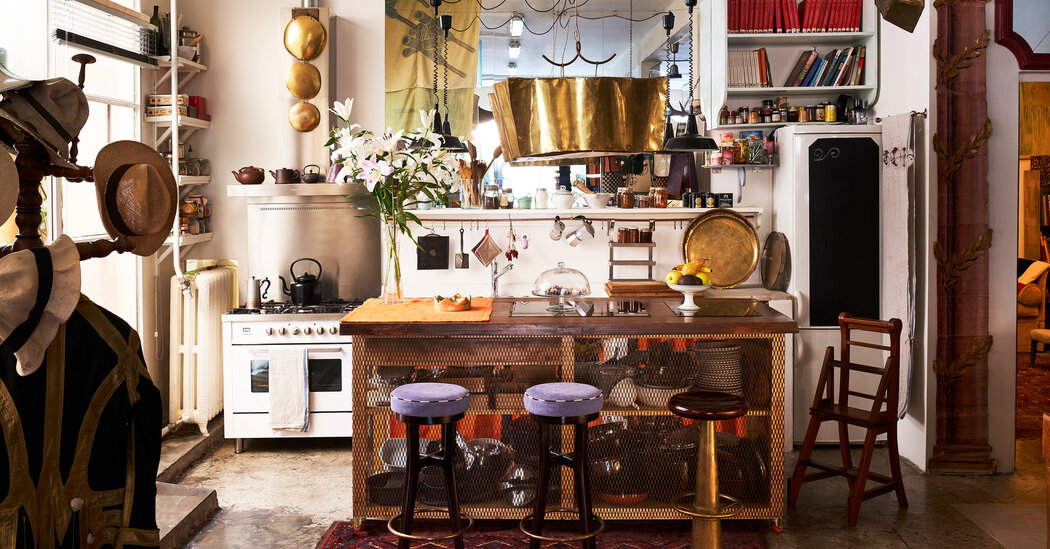With a hand-rolled cigarette pinched between his fingers, the architect and designer Roberto Gerosa, 71, is rushing around his house, a cavernous former lumber workshop in Milan’s residential Villapizzone district, pointing out his favorite objects. In the corner that serves as his office, he presents a 13-foot-tall gilded column that was once part of a 19th-century theater set. Against a nearby wall is a wooden bookcase heaving with bolts of vivid fabrics: glossy heirloom brocades, pinstriped cottons and his most recent acquisition, from a tour of markets in Provence, a 19th-century paisley cashmere shawl that he plans to repurpose for a client’s upholstered headboard. In the guest bathroom is a birdcage-shaped metal shower stall of his own design painted Yves Klein blue and crowned with a bouquet of ostrich feathers.
Gerosa moved into the 2,100-square-foot space, which has a basement studio of the same size, in 2020, in search of a place where he could both live and work. “But I didn’t want to make a typical architect’s loft,” he says. “That’s not my style.” Instead, he’s created a warm, irreverent home and atelier that speaks to a lifetime of collecting and curating forgotten objects. The layout of the single-story building — which is open save for the guest suite at the back and the primary bedroom at the front — allows Gerosa to keep his various passions at his fingertips. In the span of a few moments, he might arrange flowers in the kitchen, pull reference books off the shelves in the office, then disappear into the workshop, where he resuscitates vintage furniture.
Over the past several decades, Gerosa has earned a reputation reimagining homes for members of Milan’s bohemian aristocracy. He is often called in once a drafty Venetian palazzo or opulent city pied-à-terre has been tidily renovated and needs an injection of elegance and patina. “When I enter a room, I can see it transform,” says Gerosa. The finished spaces are dramatic and whimsical, filled with custom furniture, abundant greenery and patterned vintage textiles from his vast collection. In a stately apartment in Milan, he hung lace curtains along the walls, topping them with antique framed etchings and festooning the windows with gold-colored taffeta. He left a villa in Sicily mostly spare and whitewashed but accented the foyer with an antique pommel horse and sculptures of donkeys made from woven jute. “I have nothing against modernity,” he says. “It just doesn’t belong to me or my taste.”
Gerosa grew up in Albenga, a seaside village on Italy’s northwestern Mediterranean coast, where his family owned a construction business. “I was born in a building site,” he says. “I was playing in the sand with all the workers.” At 18, he left home to study architecture in Florence, where he met his former wife, the artist Camilla d’Afflitto, who died in 2020, and welcomed two daughters, Alice, now 40 and an academic, and Angelica, now 39 and an illustrator. In the 1990s, Gerosa spent a period in New York, where he made his name designing sculptural lamps. Nearly 40 years later, he still makes lighting in brass, stone, paper and other found materials by hand in his atelier.
Upstairs, lamps also dominate almost every corner of the living space. They hang from the ceiling and peer down from the tops of walls. In the entranceway, a cloud-shaped Tuscan alabaster sconce by Gerosa washes the stark white paint with a pinkish glow. His earliest pieces, from the 1990s — among them, a six-foot-wide star that is now suspended beside the kitchen window — were fashioned out of parchment and copper wire. “I like using rough and industrial materials, trying to turn them into something beautiful,” he says. Recent creations, including a table lamp with a crudely cut-out face and zip ties resembling spiky green hair, showcase his interest in fiberglass.
Pieces of furniture Gerosa made in the 1990s and 2000s for Milan’s Eclectica Gallery, one of Europe’s first collectible design galleries, are also scattered around the house. He keeps an 11-foot-long midnight blue velvet version of his 2001 Eclectica couch, a mix between a Regency-style sofa and a daybed embroidered with scrolled detailing on the backrest, in the sitting area opposite an ornately carved 19th-century Chinese wedding bed that belonged to his wife. There’s a smaller gold version in the guest room between an antique Indian copper bed and a wall of d’Afflitto’s abstract paintings.
Though the house may seem charmingly chaotic, there’s a method to its madness. “If you have a lumber workshop like this, you can’t transform it into Versailles,” says Gerosa. “To bring out the atmosphere of a space, you have to understand it.” At night, when the dozens of lamps are lit, the home is particularly inviting. He cooks often for friends — sometimes risotto with radicchio, or a Thai-style chicken with ginger — and his dining table, a massive wooden workbench from a weaving mill, is deliberately low and surrounded by armchairs. They’re more comfortable than traditional dining chairs, he insists, so a conversation can last well into the night. “I’m not designing for taste,” he says. “I’m designing for life.”
